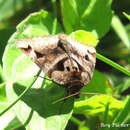Conservation Status
provided by University of Alberta Museums
A common widespread species; no concerns.
- license
- cc-by-nc
- copyright
- University of Alberta Museums
Cyclicity
provided by University of Alberta Museums
In Alberta adults fly in late May and June.
- license
- cc-by-nc
- copyright
- University of Alberta Museums
Distribution
provided by University of Alberta Museums
Quebec west to western Alberta, north to the Northwest Territories and south to the Gulf of Mexico. In mesic habitats throughout most of Alberta, from the Milk River to the Caribou Mountains. Cuspidea is replaced in BC by the very closely related and similar appearing E. ardita.
- license
- cc-by-nc
- copyright
- University of Alberta Museums
General Description
provided by University of Alberta Museums
A medium-size (2.8-3.6 cm wingspan) broad-winged dark black-brown diurnal moth. The forewings are dark brown, with a blackish antemedian band prominently toothed on its proximal side, and a narrower post-median band with a dark triangle at its upper end. The terminal area is broadly light brown. The hindwings are black-brown, with one or two narrow faint postmedian lines and a broad orange-brown terminal band. The antennae are simple and the sexes are similar. Other Alberta grass-moths (Caenurgina sp.) are lighter grey or grey brown in color. In flight Euclidia greatly resemble skippers of the genus Erynnis; they flush from the ground and fly rapidly for 20 meters or so before dropping back to the ground.
- license
- cc-by-nc
- copyright
- University of Alberta Museums
Habitat
provided by University of Alberta Museums
Grassy wooded edges, clearings and mesic meadows with long grass.
- license
- cc-by-nc
- copyright
- University of Alberta Museums
Life Cycle
provided by University of Alberta Museums
The Toothed sombrewing is unusual in that the adults are active both during the day and the night, and are attracted to light. They also come to sugar bait (Handfield, 1999). There appears to be a single annual brood. The larvae are slender and cylindrical, brown with fine longitudinal striation, forming subdorsal, stigmatal and subventral bands, with the stigmatal stripe comprised of four striae and running onto the side of the head (Forbes, 1954).
- license
- cc-by-nc
- copyright
- University of Alberta Museums
Trophic Strategy
provided by University of Alberta Museums
Clover (Trifolium sp.) and grasses (Graminiae) (Forbes, 1954); also reported to use sweetfern (Comptonia sp.) and lupine (Lupinus sp.) (Covell, 1984).
- license
- cc-by-nc
- copyright
- University of Alberta Museums
Euclidia cuspidea
provided by wikipedia EN
- license
- cc-by-sa-3.0
- copyright
- Wikipedia authors and editors
Euclidia cuspidea: Brief Summary
provided by wikipedia EN
Euclidia cuspidea, the toothed somberwing, is a moth of the family Erebidae. The species was first described by Jacob Hübner in 1818. It is found in North America from Quebec west to western Alberta, north to the Northwest Territories and south to the Gulf of Mexico.

The wingspan is 28–36 mm. Adults are on wing from May to June depending on the location.
The larvae feed on various clovers and grasses.
- license
- cc-by-sa-3.0
- copyright
- Wikipedia authors and editors

